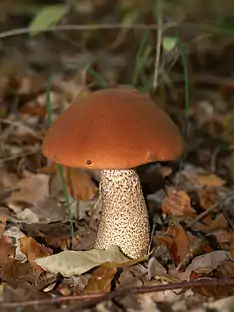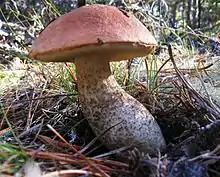Leccinum aurantiacum
Leccinum aurantiacum is a species of fungus in the genus Leccinum found in forests of Europe, North America, and Asia and has a large, characteristically red-capped fruiting body. In North America, it is sometimes referred to by the common name red-capped scaber stalk. Some uncertainties exist regarding the taxonomic classification of this species in Europe and North America. It is considered edible.
| Leccinum aurantiacum | |
|---|---|
 | |
| L. aurantiacum in a Luxembourg wood | |
| Scientific classification | |
| Kingdom: | |
| Division: | |
| Class: | |
| Order: | |
| Family: | |
| Genus: | |
| Species: | L. aurantiacum |
| Binomial name | |
| Leccinum aurantiacum | |
| Synonyms | |
| |
| Leccinum aurantiacum | |
|---|---|
float | |
| pores on hymenium | |
| cap is convex | |
| hymenium is adnate | |
| stipe is bare | |
| spore print is olive | |
| ecology is mycorrhizal | |
| edibility: choice | |
Description
The cap is orange-red and measures 5–15 centimetres (2–6 inches) across.[1] Its flesh is white, bruising at first burgundy, then grayish or purple-black. The underside of the cap has very small, whitish pores that bruise olive-brown. The stem measures 8–16 cm (3–6 1⁄2 in) tall and 2–3 cm (3⁄4–1 1⁄4 in) thick[1] and can bruise blue-green. It is whitish, with short, rigid projections or scabers that turn to brown to black with age.
Distribution and habitat
L. aurantiacum can be found fruiting during summer and autumn in forests throughout Europe and North America. The association between fungus and host tree is mycorrhizal. In Europe, it has traditionally been associated with poplar trees. Some debate exists about the classification of L. aurantiacum and L. quercinum as separate species. According to authors who do not recognise the distinction, L. aurantiacum is also found among oak trees. Additionally, L. aurantiacum has been recorded with various other deciduous trees, including beech, birch, chestnut, willow, and trees of the genus Tilia.[2] L. aurantiacum is not known to associate with conifers in Europe.
North American populations have been recorded in coniferous and deciduous forests, though whether collections from coniferous forests are not L. vulpinum, instead, remains uncertain. In addition, L. aurantiacum may be absent altogether from North America, with collections from deciduous forests being attributed to other North American species L. insigne, and L. brunneum.[3]
Edibility
This is a favorite species for eating[1] and can be prepared as other edible boletes. Its flesh turns very dark on cooking. Like most members of the Boletaceae, these mushrooms are targeted by maggots. Due to a number of poisonings and the difficulty identifying species, Leccinum species are considered by some as possibly not safe to eat. This species also needs to be cooked well (not parboiled) or else it may cause vomiting or other negative effects. This species can cause problems with digestion if not cooked properly.
Similar species
In Europe, several orange-red capped species exist, which differ mainly in habitat. L. albostipitatum grows with aspen and has white scales on the stipe. In coniferous forests, L. vulpinum occurs around pine and spruce trees. Not all authors recognise these as distinct species.
In North America, L. insigne grows in aspen or birch stands, while L. atrostipitatum grows in birch stands. Both are edible.
References

- National Audubon Society Field Guide to North American Mushrooms, Knopf, 1981.
- Phillips, Roger (2010). Mushrooms and Other Fungi of North America. Buffalo, NY: Firefly Books. p. 279. ISBN 978-1-55407-651-2.
- "The genus Leccinum in Western and Central Europe". Noordeloos M. Retrieved July 8, 2010.
- "Leccinum: Uncertain taxa". Kuo M. Retrieved July 8, 2010.
External links
| Wikimedia Commons has media related to Leccinum aurantiacum. |
- Leccinum aurantiacum at MushroomExpert.com
- Leccinum aurantiacum at MykoWeb
- Leccinum aurantiacum Leccinum Species May No Longer Be Considered Safe